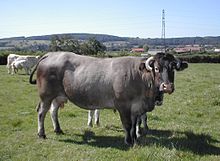Bazadais
 |
|
| Conservation status | FAO (2007): not at risk |
|---|---|
| Other names | Bazadais |
| Country of origin | France |
| Distribution | Aquitaine, Midi-Pyrénées |
| Traits | |
| Weight |
|
| Height |
|
| Skin colour | black |
| Coat | grey |
| Horn status | horned in both sexes |
|
|
The Bazadaise is a French breed of beef cattle. It takes its name from the town of Bazas in the département of the Gironde, in the Nouvelle-Aquitaine region of south-western France, and originates in the low-lying areas to the south of the River Garonne near that town. A festival, the Fête des Boeufs Gras, is held each year in Bazas to present fattened Bazadaise stock.
The Bazadaise is a traditional draught breed of the Pyrénées and the Gironde, in the Nouvelle-Aquitaine region of south-western France. It is thought to result from inter-breeding of local cattle of Aquitaine with others of Spanish origin. It is named for the town of Bazas in the Gironde, and is still strongly associated with it: an annual festival, the Fête des Boeufs Gras, is held each year in Bazas to celebrate and present the Bazadaise and its meat, which is heavily marbled and renowned for its tenderness and flavour.
A herd-book for the Bazadaise was established on 31 July 1896. The breed was formerly numerous: there were about 60 000 head in 1940. In the years after the Second World War, the mechanisation of agriculture and more extensive cultivation of cereal crops in the region both contributed to a rapid decline in numbers. By 1970 only 700 cows remained, and efforts to recover and conserve the breed began. In 2013 there were about 3400 cows, in more than 140 farms.
...
Wikipedia
